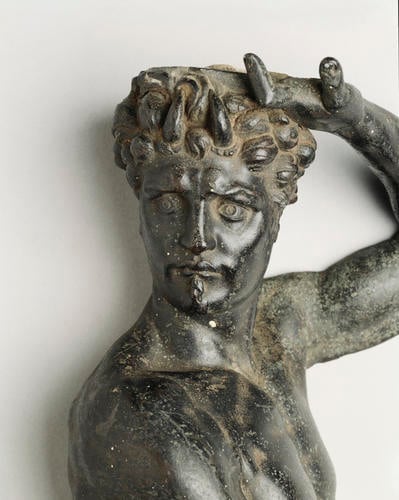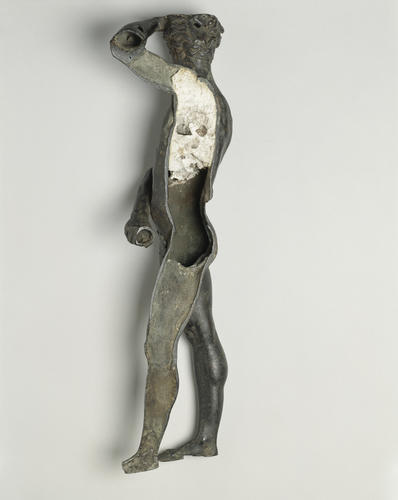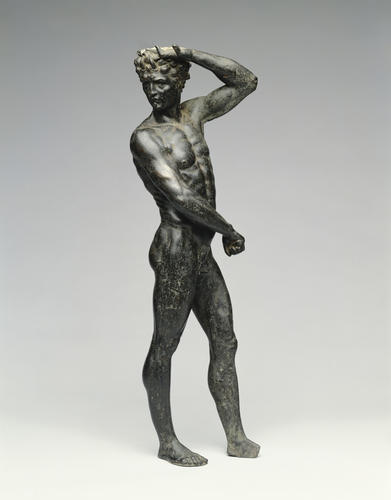-
1 of 253523 objects
Satyr c. 1545
Bronze | 57.0 x 19.0 x 10.5 cm (whole object) | RCIN 94784

Benvenuto Cellini (1500-71)
Satyr c. 1545

Benvenuto Cellini (1500-71)
Satyr c. 1545

Benvenuto Cellini (1500-71)
Satyr c. 1545




-
A bronze statuette of a naked satyr. The full-length figure cast in three-quarter relief with a hollow back. The head with densely curled hair, horns to the forehead and beetled brow, turned sharply to his right. He stands with his left foot extended one pace in front of the right (the front half of the left foot is missing). His left arm, which is bent at the elbow, is held up with the hand resting, palm upwards, on the left side of his head. His right arm is held downwards, across his twisted, muscular torso. In his right hand, which is twisted to the left, he grips a short billet. The surface of the figure is covered with a broken grey-green organic patina. The hollow back is open. The upper part of the torso is filled with white plaster enclosing fragments of burnt clay and two wooden pegs. The flattened top and the back of the
head have cast-in additions, and the top is partly filled with plaster.
Little survives of the work completed by Benvenuto Cellini (1500-1571) during his sojourn at the court of Francis I between 1540 and 1545, with the great exception of the famous salt cellar with confronted gold figures emblematic of Earth and Water (Kunsthistorisches Museum, Vienna). The King’s most elaborate commission, conveyed to Cellini in person in January 1542, was for a group of colossal bronzes to adorn the Porte Dorée at Fontainebleau, a monumental doorway that was to become the principal ceremonial entrance to the chateau. This was Cellini’s first venture in large-scale bronze sculpture (his Perseus in Florence dates from ten years later). The King’s sole prescription, recorded in Cellini’s autobiography, was that there should be a representation of the Source de Fontainebleau, a female native of the hunting forest, guardian of its spring.
In the space of ten days, Cellini worked up a model of his design for the King’s approval. The segmental head of the doorway would be filled by a relief of the reclining Source surrounded by forest creatures. Below, supporting this lunette on each side, in place of columns, Cellini designed two satyrs. One was ‘fiery and menacing, instilling fear in the beholder’: the other had the same posture of support; but I had varied his features and some other details; in his hand, for instance, he held a flail with three balls attached to chains. Though I call them satyrs, they showed nothing of the satyr except little horns and a goatish head; all the rest of their form was human.’
The scheme was approved. The Source relief was cast in bronze in 1544 (Musée du Louvre, Paris) and the two satyrs were developed in plaster at full size, standing over 3 metres high. However, these models were left in Cellini’s workshop in Paris on his final departure for Italy in June 1545 and the project was never realised. Aside from Cellini’s description and a drawing representing one of the plaster models (National Gallery of Art, Washington, DC), the present statuette and its counterpart (J. Paul Getty Museum, Los Angeles) are the only records of the intended appearance of the figures. Their surfaces are very different because the Getty statuette seems to have been repatinated during its passage through the trade, whereas this one was not. Its surface is different from that of almost any other sixteenth-century Italian bronze, but that in itself makes it a great rarity. The two bronzes share many similarities; their dimensions in all directions are so close that when placed back-to-back they fit together like two halves of a clam shell. Yet there is strong evidence to suggest that different techniques were used both in the modelling and casting of the figures. The Getty statuette was most likely modelled on an armature as a standing figure, whereas this bronze must have been modelled up in relief, on a board. The Getty statuette has the characteristics of a direct lost-wax cast, whereas this work seems to have been cast indirectly. These differences do not, however, prove that they were made in different workshops, because Cellini’s Paris foundry was a place of constant experiment.
Cellini was critical of the ‘vicious French style’ of the doorway, designed in 1528 by Gilles le Breton. He had sought to correct its proportions by placing his bronzes so as to conceal the existing architecture, but recent attempts at reconstructing the scheme on paper suggest that these difficulties may have proved insurmountable. Opinion is divided on the precise role the two surviving small bronzes played in this story, but they seem to have been cast during the lifetime of the project. Their virtuosity, and especially the use of paired opposites - youth and age, beauty and ugliness, tranquillity and suffering, intelligence and brutality - and the evident indebtedness of the younger figure to Michelangelo’s David, invite speculation as to the impact the doorway might have had on an artistic milieu accustomed hitherto, where large bronzes were concerned, to Primaticcio’s pedestrian facsimiles of the Antique.
This is probably identifiable as one of the ‘2 Bronze Fawn Basso Relieves 22 Inches’, recorded as having been in storage in the Riding House at Carlton House in 1826. The other figure was most probably the Getty satyr, which was subsequently recorded in the Windsor Castle Inventory: Bronzes. It appears on a page devoted to other detached or dissociated bronzes that were kept in store, including a set of Four Seasons mounts from models used by A.-C. Boulle, presumably from an imposing piece of French furniture. A note by the compiler of the inventory, James Hollis, dated 12 November 1875, states: ‘This Figure has evidently been fitted as a support to some piece of furniture. Thumb of right hand broken–gone.’ The evidence of the broken thumb puts the identification with the Getty statuette beyond question, since it retains clear evidence of such damage. Neither the date nor the circumstances of the departure of this bronze from the Royal Collection is known. The conjecture by the Inventory Clerk gives rise to the hypothesis that both satyrs were at some point in their history incorporated into a piece of furniture. For reasons of fashion or inconvenience they later became detached. This may have been when the piece of furniture itself was disposed of, and the bronzes retained as possibly of some future use or value.
Although the first record of the Cellini satyrs in the Royal Collection is as detached ‘Basso Relievos’ in the time of George IV, there is no record of his having purchased them. In any case they are unlikely to have been traded as antiques as they would have had little appeal to the collector of bronzes. If this bonze had at any time been in the trade it might be expected that at some point or another it would have been repatinated or at least polished.
Catalogue entry adapted from The Northern Renaissance. Dürer to Holbein (2011) and Sculpture in the Collection of His Majesty The King (2025)Provenance
(Probably) Carlton House, Pediment Store (1826); ? Windsor Castle; Buckingham Palace.
-
Creator(s)
-
Medium and techniques
Bronze
Measurements
57.0 x 19.0 x 10.5 cm (whole object)
Category
Object type(s)